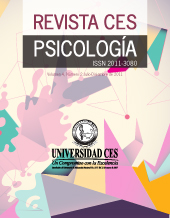Observando la mentalización en psicoterapias con adolescentes: Diseño de un sistema de observación de la interacción terapéutica
DOI:
https://doi.org/10.21615/cesp.13.3.4Palavras-chave:
Mentalización, Tratamiento basado en la Mentalización, Psicoterapia con Adolescentes, Investigación de Proceso en PsicoterapiaResumo
Objetivo: Basado en la falta de medidas que permitan evaluar la mentalización como variable de proceso en psicoterapias con adolescentes, el siguiente estudio apunta a presentar el diseño de un sistema observacional para evaluar el despliegue de esta variable tanto en pacientes como en terapeutas. Método: mediante el proceso de codificación abierta de la teoría fundamentada y análisis temático de tres niveles, se analizó el despliegue de la mentalización tanto en terapeutas como en pacientes en 10 episodios de ruptura y 10 episodios de resolución elegidos aleatoriamente de cinco psicoterapias con adolescentes. Resultados: A partir del análisis efectuado se desarrolló un sistema observacional de seis dimensiones emergentes (foco en los estados mentales, opacidad de los estados mentales, comunicación contingente, causalidad de los estados mentales, naturaleza dinámica de los estados mentales y foco en el momento presente) denominado “Sistema de Observación de la mentalización en Psicoterapia con adolescentes” (OMP-A) que permite evaluar cuantitativamente la mentalización de terapeutas y pacientes. Discusión y conclusiones: el OMP-A es un instrumento que responde a debilidades de otros sistemas para evaluar mentalización en psicoterapia con adolescentes, permitiendo la observación de aspectos lingüísticos y paralingüísticos del mentalizar y toma en consideración aspectos particulares que caracterizan las intervenciones con adolescentes. Se discute su posible uso para la formación y supervisión en psicoterapia, y los desafíos metodológicos para desarrollos futuros.
Downloads
Referências
Allen, J. & Fonagy, P. (2006). Handbook of mentalization-based treatment. J.G. Allen & P. Fonagy (Eds.), New York: Wiley.
Asen, E., & Fonagy, P. (2012). Mentalization‐based therapeutic interventions for families. Journal of Family Therapy, 34(4), 347-370. https://doi.org/10.1111/j.1467-6427.2011.00552.x
Bateman, A. W., & Fonagy, P. (2004). Mentalization-based treatment of BPD. Journal of personality disorders, 18(1), 36-51. https://psycnet.apa.org/doi/10.1521/pedi.18.1.36.32772
Bateman, A., Peter (Psychoanalysis Unit Fonagy, & Fonagy, P. (2004). Psychotherapy for borderline personality disorder. Oxford: Oxford University Press.
Bateman, A., & Fonagy, P. (2006). Mentalization-based treatment for personality disorders: A practical guide. Reino Unido: Oxford University Press.
Bateman, A. W., & Fonagy, P. (Eds.). (2012). Handbook of mentalizing in mental health practice. London: American Psychiatric Association Publishing.
Bateman, A. W., & Fonagy, P. (Eds). (2019). Handbook of mentalizing in mental health practice. London: American Psychiatric Association Publishing.
Bevington, D., Fuggle, P., Fonagy, P., Target, M., & Asen, E. (2013) Innovations in Practice: Adolescent Mentalization-Based Integrative Therapy (AMBIT). Child and Adolescent Mental Health, 18 (1), 46 - 51.
https://doi.org/10.1111/j.1475-3588.2012.00666.x
Binder, P. E., Holgersen, H., & Nielsen, G. H. (2008). Establishing a bond that works: A qualitative study of how psychotherapists make contact with adolescent patients. European Journal of psychotherapy and counselling, 10(1), 55-69. https://doi.org/10.1080/13642530701869730
Bleiberg E., Rossouw T., & Fonagy P. (2012). Adolescent breakdown and emerging personality disorder. In Bateman AW, Fonagy P (eds). Handbook of mentalizing in mental health practice (p. 463-509). Washington, DC: American Psychiatric Publishing.
Bo, S., Sharp, C., Beck, E., Pedersen, J., Gondan, M., & Simonsen, E. (2017). First empirical evaluation of outcomes for mentalization-based group therapy for adolescents with BPD. Personality Disorders: Theory, Research, and Treatment, 8(4), 396. https://psycnet.apa.org/doi/10.1037/per0000210
Charmaz, K. (2014). Constructing grounded theory. A practical guide through qualitative analysis (2nd ed.). Thousand Oaks, CA: Sage
Choi-Kain, L., & Gunderson, J. (2008). Mentalization: Ontogeny, assessment and application in the treatment of borderline personality disorder. Am J Psychiatry, 165(9): 1127-1135. https://doi.org/10.1037/per0000210
Cortina, M., Liotti, G., & Silberman, M. (2012). Cooperación, intersubjetividad y apego. Aperturas Psicoanalíticas, 41. http://www.aperturas.org/articulo.php?articulo=0000750
De la Cerda, C., Martínez, C., & Tomicic, A. (2018). La función reflexiva como aprendizaje procedural en la interacción terapéutica: el funcionamiento reflexivo-relacional. Revista Argentina de Clínica Psicológica, 28(3), 285–294. http://doi.org/10.24205/03276716.2019.1142
Dziobek, I., Fleck, S., Kalbe, E., Rogers, K., Hassenstab, J., Brand, M., ... Convit, A. (2006). Introducing MASC: a movie for the assessment of social cognition. Journal of autism and developmental disorders, 36(5), 623-636. https://doi.org/10.1007/s10803-006-0107-0
Eubanks-Carter, C., Muran, J. C., & Safran, J. D. (2014). Rupture resolution rating system (3RS): Manual. Unpublished manuscript, Beth Israel Medical Center, New York.
Fischer-Kern, M., Doering, S., Taubner, S., Hörz, S., Zimmermann, J., Rentrop, M., ... Buchheim, A. (2015). Transference-focused psychotherapy for borderline personality disorder: Change in reflective function. The British Journal of Psychiatry, 207(2), 173-174. https://doi.org/10.1192/bjp.bp.113.143842
Flick, U. (2009). An introduction to qualitative research (4th ed.). London: Sage
Frith, U., & Frith, C. D. (2003). Development and neurophysiology of mentalizing. Philosophical Transactions of the Royal Society London, Series B, 358, 685–694. https://doi.org/10.1098/rstb.2002.1218
Fonagy, P., Target, M., Steele, H., & Steele, M. (1998). Reflective-Functioning Manuel, version 5.0, for Application to Adult Attachment Interviews. London: University College London.
Fonagy, P., Gergely, G., Jurist, E. L., & Target, M. (Eds.). (2002). Affect regulation, mentalization and the development of the self. New York: Other Press.
Gensler, D. (2015). Silence in adolescent psychotherapy. Journal of Infant, Child, and Adolescent Psychotherapy, 14(2), 188-195. https://doi.org/10.1080/15289168.2015.1032635
Gullestad, F. S., & Wilberg, T. (2011). Change in reflective functioning during psychotherapy—A single-case study. Psychotherapy Research, 21(1), 97-111. https://doi.org/10.1080/10503307.2010.525759
Gullestad, F. S., Johansen, M. S., Høglend, P., Karterud, S., & Wilberg, T. (2013). Mentalization as a moderator of treatment effects: Findings from a randomized clinical trial for personality disorders. Psychotherapy Research, 23(6), 674-689. https://doi.org/10.1080/10503307.2012.684103
Hauser, S. T., Allen, J. P., & Golden, E. (2006). Out of the woods: Tales of teen resilience. Cambride: Harvard University Press.
Hörz-Sagstetter, S., Mertens, W., Isphording, S., Buchheim, A., & Taubner, S. (2015). Changes in Reflective Functioning during Psychoanalytic Psychotherapies. Journal of the American Psychoanalytic Association, 63(3), 481-509. https://doi.org/10.1177%2F0003065115591977
Katznelson, H. (2014). Reflective functioning: A review. Clinical psychology review, 34(2), 107-117. https://doi.org/10.1016/j.cpr.2013.12.003
Koo, T. K., & Li, M. Y. (2016). A guideline of selecting and reporting intraclass correlation coefficients for reliability research. Journal of chiropractic medicine, 15(2), 155-163. https://doi.org/10.1016/j.jcm.2016.02.012
Levy, K. N., Meehan, K. B., Kelly, K. M., Reynoso, J. S., Weber, M., Clarkin, J. F., & Kernberg, O. F. (2006). Change in attachment patterns and reflective function in a randomized control trial of transference-focused psychotherapy for borderline personality disorder. Journal of consulting and clinical psychology, 74(6), 1027-1040. https://doi.apa.org/doi/10.1037/0022-006X.74.6.1027
Liljenfors, R., & Lundh, L. G. (2015). Mentalization and intersubjectivity towards a theoretical integration. Psychoanalytic Psychology, 32(1), 36-60 https://doi.apa.org/doi/10.1037/a0037129
Lingiardi, V., & Colli, A. (2015). Therapeutic Alliance and Alliance Ruptures and Resolutions: Theoretical Definitions, Assessment Issues, and Research Findings. En O. Gelo, A. Pritz, & B. Rieken (Eds.), Psychotherapy Research: Foundations, Process and outcome. London: Springer.
Luyten, P., Fonagy, P., Lowyck, B., & Vermote, R. (2012). Assessment of mentalization. In A. W. Bateman, & P. Fonagy (Eds.), Handbook of mentalizing in mental health practice (pp. 43-65). Arlington, VA, US: American Psychiatric Publishing, Inc.
Main, M., Goldwyn, R., & Hesse, E. (2003). The Adult Attachment Interview: Scoring and Classification System, Version 7.2. Unpublished manuscript, University of California at Berkeley.
Martínez, C. M., Tomicic, A., De la Cerda, C., Rivera, M. J., & Salas, C. (2017). Función Reflexiva en Primeras Entrevistas de Psicoterapia: Un Estudio Exploratorio sobre el Papel de la Mentalización en la Interacción Terapéutica. Revista Argentina de Clínica Psicológica, 26(3), 274-282. https://doi.org/10.24205/03276716.2017.1026
McLeod, B. D., Jensen-Doss, A., Tully, C. B., Southam-Gerow, M. A., Weisz, J. R., & Kendall, P. C. (2016). The role of setting versus treatment type in alliance within youth therapy. Journal of consulting and clinical psychology, 84(5), 453-464. https://doi.apa.org/doi/10.1037/ccp0000081
Magill-Evans, J., Koning, C., Cameron-Sadava, A., & Manyk, K. (1995). The child and adolescent social perception measure. Journal of Nonverbal Behavior, 19(3), 151-169. https://doi.org/10.1007/BF02175502
Meins, E., Fernyhough, C., de Rosnay, M., Arnott, B., Leekam, S. R., & Turner, M. (2012). Mind‐mindedness as a multidimensional construct: Appropriate and nonattuned mind‐related comments independently predict infant–mother attachment in a socially diverse sample. Infancy, 17(4), 393-415. https://doi.org/10.1111/j.1532-7078.2011.00087.x
Morán, J., Díaz, M. F., Martínez, C., Varas, C., & Sepúlveda, R. P. (2019). The subjective experience of psychotherapists during moments of rupture in psychotherapy with adolescents. Research in Psychotherapy: Psychopathology, Process and Outcome, 22(1). https://doi.org/10.4081/ripppo.2019.346
Morken, K., Karterud, S., & Arefjord, N. (2014). Transforming disorganized attachment through mentalization-based treatment. Journal of Contemporary Psychotherapy, 44(2), 117-126 https://doi.org/10.1007/s10879-013-9246-8
Rossouw, T. I., & Fonagy, P. (2012). Mentalization-based treatment for self-harm in adolescents: a randomized controlled trial. Journal of the American Academy of Child & Adolescent Psychiatry, 51(12), 1304-1313. https://doi.org/10.1016/j.jaac.2012.09.018
Rossouw, T. I. (2015). The Use of Mentalization‐Based Treatment for Adolescents (MBT‐A) With a Young Woman with Mixed Personality Disorder and Tendencies to Self‐Harm. Journal of clinical psychology, 71(2), 178-187. https://doi.org/10.1016/j.jaac.2012.09.018
Ruffman, T., Slade, L., & Crowe, E. (2002). The relation between children’s and mother’s mental state language and theory of mind understanding. Child development, 73(3), 734-751. https://doi.org/10.1111/1467-8624.00435
Safran, J. D., & Muran, J. C. (1996). The resolution of ruptures in the therapeutic alliance. Journal of consulting and clinical psychology, 64(3), 447. https://doi.apa.org/doi/10.1037/0022-006X.64.3.447
Safran, J. D., & Muran, J. C. (2005). La alianza terapéutica. Una guía para el tratamiento relacional. Bilbao: Desclée de Brouwer.
Talia, A., Miller-Bottome, M., Katznelson, H., Pedersen, S. H., Steele, H., Schröder, P., ... Lingiardi, V. (2019). Mentalizing in the presence of another: Measuring reflective functioning and attachment in the therapy process. Psychotherapy Research, 29(5), 652-665. https://doi.org/10.1080/10503307.2017.1417651
Tobin, G. A., & Begley, C. M. (2004). Methodological rigour within a qualitative framework. Journal of advanced nursing, 48(4), 388-396. https://doi.org/10.1111/j.1365-2648.2004.03207.x
Schore, J., & Schore, A. (2007). Modern Attachment Theory: A Central Role of Affect Regulation in Development and Treatment. Clinical Social Work Journal, 36(1), 9-20. https://doi.org/10.1007/s10615-007-0111-7
Sharp, C., & Fonagy, P. (2008). The parent “s capacity to treat the child as a psychological agent: Constructs, measures and implications for developmental psychopathology. Social Development, 17(3), 737-754. https://doi.org/10.1111/j.1467-9507.2007.00457.x
Sharp, C., & Fonagy, P. (2015). Practitioner review: borderline personality disorder in adolescence–recent conceptualization, intervention, and implications for clinical practice. Journal of Child Psychology and Psychiatry, 56(12), 1266-1288. https://doi.org/10.1111/jcpp.12449
Spunt, R. P., Satpute, A. B., & Lieberman, M. D. (2011). Identifying the what, why, and how of an observed action: an fMRI study of mentalizing and mechanizing during action observation. Journal of cognitive neuroscience, 23(1), 63-74. https://doi.org/10.1162/jocn.2010.21446
Valdés, C., Morales-Reyes, I., Pérez, J. C., Medellín, A., Rojas, G., & Krause, M. (2017). Propiedades psicométricas del Inventario de Depresión de Beck IA para la población chilena. Revista médica de Chile, 145(8), 1005-1012. http://dx.doi.org/10.4067/s0034-98872017000801005
Vrouva, I., Target, M., & Ensink, K. (2013). Measuring mentalization in children and young people. In Minding the Child (pp. 68-90). Routledge.
Downloads
Publicado
Como Citar
Edição
Seção
Licença
Copyright (c) 2020 CES Psicología

Este trabalho está licenciado sob uma licença Creative Commons Attribution-NoDerivatives 4.0 International License.
Revista CES Psicología ISSN 2011 3080
Facultad de Psicología, Universidad CES Primera edición 2008. Última actualización Mayo 18 de 2022. Todos los derechos reservados. Hecho el depósito legal que exige la ley.
Se autoriza la reproducción total o parcial de los artículos citando la fuente y el autor. This publication may be reproduced by mentioning the source and the authors.
| Métricas do artigo | |
|---|---|
| Vistas abstratas | |
| Visualizações da cozinha | |
| Visualizações de PDF | |
| Visualizações em HTML | |
| Outras visualizações | |




